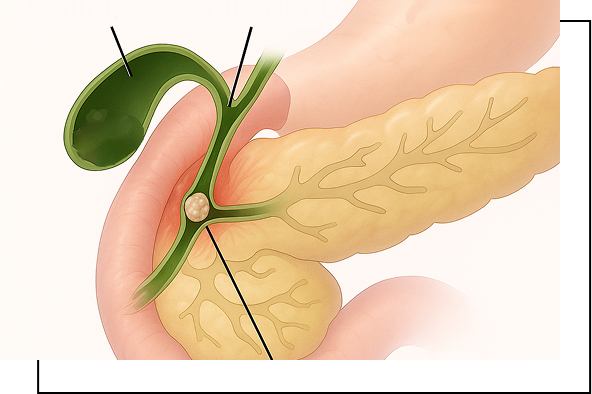Bile Duct Stone Treatment Doctor in Kolkata
Home > Gallbladder Diseases > Common Bile Duct Stone
Overview
A common bile duct stone, or choledocholithiasis, forms in the bile duct and blocks the bile duct, either forming in the bile duct or traveling there from your gallbladder, causing severe discomfort and potential complications. Without timely intervention, this condition can cause various digestive problems and lead to infections or pancreatitis.

Common Bile Duct Stone Symptoms
Common bile duct stones often don’t cause any symptoms, especially if they are small. However, if a stone blocks the duct, it can lead to a backup of bile, causing the following symptoms:
Jaundice: Yellowing of skin and eyes
Severe abdominal pain
Dark urine and pale/clay-colored stools
Bloating and a feeling of fullness
Sharp pain in your upper abdomen
Nausea and vomiting
Sharp pain in your upper abdomen
Nausea and vomiting
Note: These symptoms can vary in intensity and may mimic other conditions. Persistent discomfort should not be ignored. Consult Dr. Debjoy Sau, a renowned specialist in bile duct stone removal treatment in Kolkata.
Causes and Risk Factors
Bile duct stones form when bile contains too much cholesterol, bile salts, or bilirubin. Factors increasing risk include:
Gallbladder stone size 3mm
Age over 40
Previous gallbladder problems
Chronic liver disease
Family history
Certain medications
Obesity and rapid weight loss
Infections
Hemolytic anemia
Diabetes
Evaluation
Timely evaluation by a bile duct stone removal doctor in Kolkata can help prevent complications.
Ultrasound, CT scans, or Magnetic Resonance Cholangiopancreatography (MRCP)
Blood tests to assess liver function
Endoscopic Retrograde Cholangiopancreatography (ERCP)

Management
The treatment for common bile duct stones depends on the location and stage of the disease, which may include:
ERCP (Endoscopic Removal)
Laparoscopic bile duct stone surgery for larger or multiple stones
Open Surgery in complex cases
Medications to dissolve small stones or manage symptoms
Lifestyle changes
Managing balanced diet
Book An Appointment
FAQs
Know Your Answers
What is ERCP?
ERCP is a minimally invasive endoscopic procedure to locate and remove stones from the bile and pancreatic duct. During ERCP, a thin, flexible tube with a tiny camera and tools is inserted through the mouth and into the digestive system to visualize and remove stones or other obstructions in the bile ducts. Consult a bile duct stone removal doctor in Kolkata for detailed information.
Can common bile duct stones be life-threatening?
Yes, if left untreated, common bile duct stones can lead to serious complications, such as cholangitis, pancreatitis, infections, or jaundice, which can be life-threatening.
Can bile duct stones pass naturally?
Small stones may pass naturally, but most require medical intervention to prevent complications and relieve symptoms.
What is the recovery time after bile duct stone removal?
It typically takes 1-2 weeks to recover from bile duct stone removal surgery. This allows the patient’s body to heal from the procedure and for any discomfort to subside. Every patient recovers at a different pace, so it’s important to listen to your body and rest as needed.
Is bile duct stone removal permanent?
With proper lifestyle changes and follow-up care, most patients don’t experience stone recurrence after successful removal.

